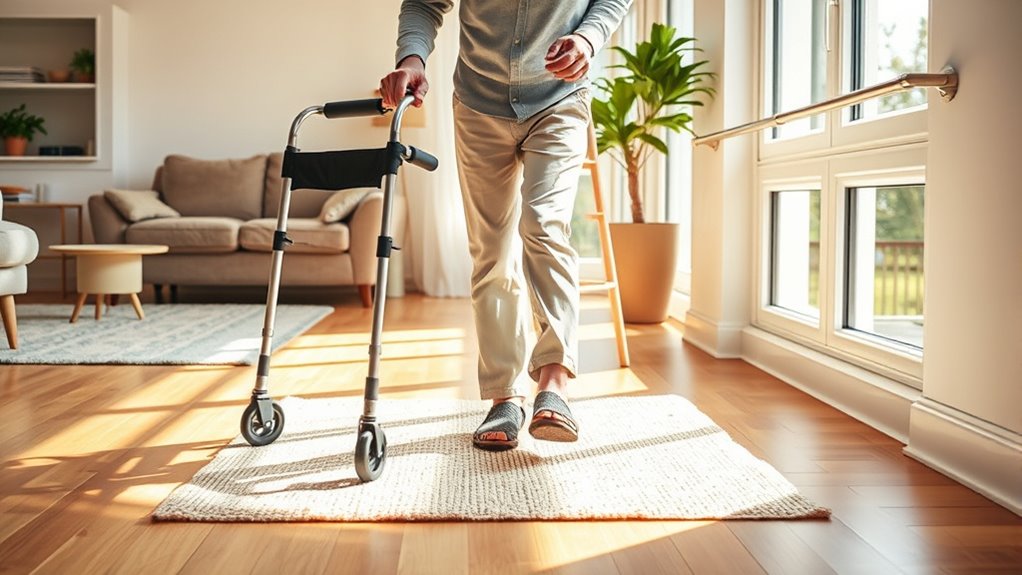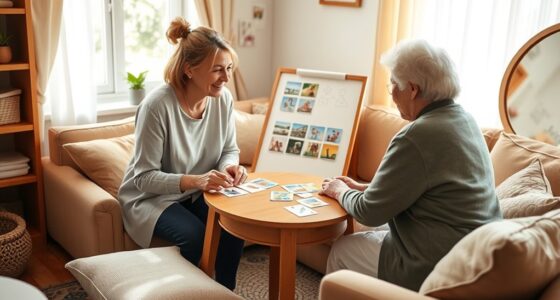To prevent falls during stroke recovery, make simple home modifications like removing clutter, securing rugs, and installing grab bars. Use assistive devices such as canes or walkers for extra stability, and wear sturdy, non-slip shoes. Develop good habits like taking your time when standing and avoiding multitasking while moving. Regular support from caregivers or therapists also boosts your confidence and safety. Keep exploring these strategies to stay safe and regain independence effectively.
Key Takeaways
- Modify the home environment by removing clutter, securing rugs, and installing grab bars for safer mobility.
- Use assistive devices like canes or walkers properly fitted and consistently during movement.
- Develop safe movement habits, such as taking time when standing and testing balance before walking.
- Seek regular professional support through physical therapy and caregiver check-ins to improve strength and safety.
- Wear sturdy, non-slip footwear and ensure adequate lighting to reduce fall risks during daily activities.

Recovering from a stroke can be challenging, and falls are a common risk during this vulnerable period. Your safety becomes a top priority as you work on regaining strength and independence. One of the most effective ways to reduce the risk of falls is by making simple home modifications. Clearing clutter from walkways, securing loose rugs, and installing grab bars in bathrooms can make a significant difference. Bright lighting throughout your home helps you see obstacles clearly, preventing trips and slips. Consider rearranging furniture so pathways are wide and unobstructed, and use non-slip mats in areas prone to moisture, like the kitchen and bathroom. These modifications create a safer environment tailored to your evolving needs.
Assistive devices play a vital role in supporting your balance and mobility. Canes, walkers, and grab bars are designed to provide stability and confidence as you move around. When choosing assistive devices, it’s essential to work with a healthcare professional or physical therapist who can recommend the right tools for your specific condition. Properly fitted devices ensure comfort and safety, reducing the likelihood of falls. Use these devices consistently, especially in areas where you feel unsteady, to build confidence and independence. Over time, your therapist might suggest additional assistive tools like ankle-foot orthoses or walking poles, which can further enhance your stability. Incorporating balance support techniques can also boost your confidence and reduce fall risk.
In addition to home modifications and assistive devices, developing good habits can substantially lower your fall risk. Take your time when shifting from sitting to standing, and avoid rushing, especially if you feel weak or dizzy. Always test your balance before walking long distances or navigating stairs. Remember to wear sturdy, non-slip shoes that provide good grip and support. Keep your hands free of clutter, so you’re prepared for sudden balance adjustments. It’s also wise to avoid multitasking while moving around—focusing solely on your steps can prevent accidents.
Lastly, don’t hesitate to seek support from caregivers, family, or healthcare providers. Regular check-ins and physical therapy sessions can help improve your strength and coordination, making falls less likely. Staying proactive about your safety by implementing home modifications and using assistive devices creates a safer environment that promotes confidence. As you continue your recovery, these measures empower you to move more freely and securely, helping you regain independence while minimizing the risk of injury.
Frequently Asked Questions
How Can Family Members Assist in Fall Prevention at Home?
You can assist in fall prevention at home by ensuring a safe environment through home safety measures like removing tripping hazards, installing grab bars, and securing rugs. Offer caregiver support by helping with daily activities and encouraging your loved one to use assistive devices. Keep pathways clear, ensure proper lighting, and regularly check for hazards. Your involvement makes a significant difference in reducing fall risks and promoting safety during stroke recovery.
Are There Specific Exercises to Improve Balance Post-Stroke?
You can do balance exercises like standing on one leg or heel-to-toe walking to improve stability. Incorporate strength training to enhance muscle support, which helps with balance. Regular practice of these exercises can boost your confidence and reduce fall risk post-stroke. Always start slowly, and consider working with a physical therapist to guarantee proper technique and safety. Consistency is key to seeing progress and regaining your balance.
What Footwear Options Reduce Fall Risk During Recovery?
You should choose footwear with non-slip soles and good ankle support, as studies suggest these features help reduce fall risk during recovery. It’s true that stable shoes can boost confidence and prevent slips on wet or uneven surfaces. Opt for shoes that fit well, offer firm grip, and support your ankles to stay steady. Wearing appropriate footwear makes a noticeable difference in keeping you safe as you regain strength and mobility.
How Does Medication Affect Fall Risk After a Stroke?
Medication can increase your fall risk after a stroke due to side effects like dizziness, drowsiness, or balance issues. Certain drugs may interact with each other, amplifying these effects, making you more prone to falls. It’s essential to discuss all your medications with your healthcare provider, report any side effects, and guarantee your prescriptions are optimized to minimize fall risk while managing your recovery effectively.
When Should I Seek Professional Help for Fall Concerns?
You should seek professional help when you notice warning signs like frequent falls, unsteady gait, or difficulty with balance and coordination. If home safety concerns, such as clutter, poor lighting, or loose rugs, heighten your fall risk, consult a healthcare provider. Addressing these issues promptly can prevent injuries and improve your recovery. Don’t wait until a fall occurs—early intervention ensures safer recovery and better support.
Conclusion
Remember, preventing falls during stroke recovery is like steering a boat through choppy waters—you need to stay alert and steady. One patient I know avoided a fall by using grab bars and taking small steps, much like a sailor steadying the helm. Did you know that falls are the leading cause of injury post-stroke? By staying cautious and following safety tips, you can navigate your recovery safely and keep your journey smooth.









